Welcome to the comprehensive guide designed to help you scale Shopify stores from $90 to $100,000 in monthly recurring revenue and beyond.
At EcommerceBot, we are dedicated to empowering e-commerce store owners with the resources and tools necessary to automate daily tasks, allowing you to focus more on growth and less on maintenance. This guide is specifically tailored for stores that have been operational and are ready to scale efficiently with a few key sales channels, generate significant traffic, and achieve high conversion rates.
What You Will Learn
In this guide, we will cover:
- Customer Service Automation: How to provide excellent customer service through automation, using tools like EcommerceBot to save time and improve satisfaction.
- Organic Traffic Growth: Long-term strategies for increasing organic traffic, including SEO, influencer marketing, and social media.
- Effective Paid Strategies: How to run effective ad campaigns with minimal effort, using AI to optimize ad spending and maximize ROI.
- Improve Customer LTV: Techniques to increase customer retention and repeat purchases, including implementing loyalty programs.
- Cart Abandonment Solutions: Proven methods and tools to reduce cart abandonment rates and recover abandoned carts.
- Optimize Conversion Rate: Strategies to improve the conversion rate on your Shopify store.
- Scaling Your Business: Steps to take when scaling your ecommerce business and managing growth while maintaining quality.
How EcommerceBot Can Help
- AI-Powered Chatbots: Automate customer service inquiries across multiple channels, including Instagram DM and Facebook DM.
- Social Media Scheduling: Schedule posts on Facebook and Instagram with a calendar feature.
- AI LiveChat: Engage customers with product images, buy-now buttons, add-to-cart options, and email collection directly in chat.
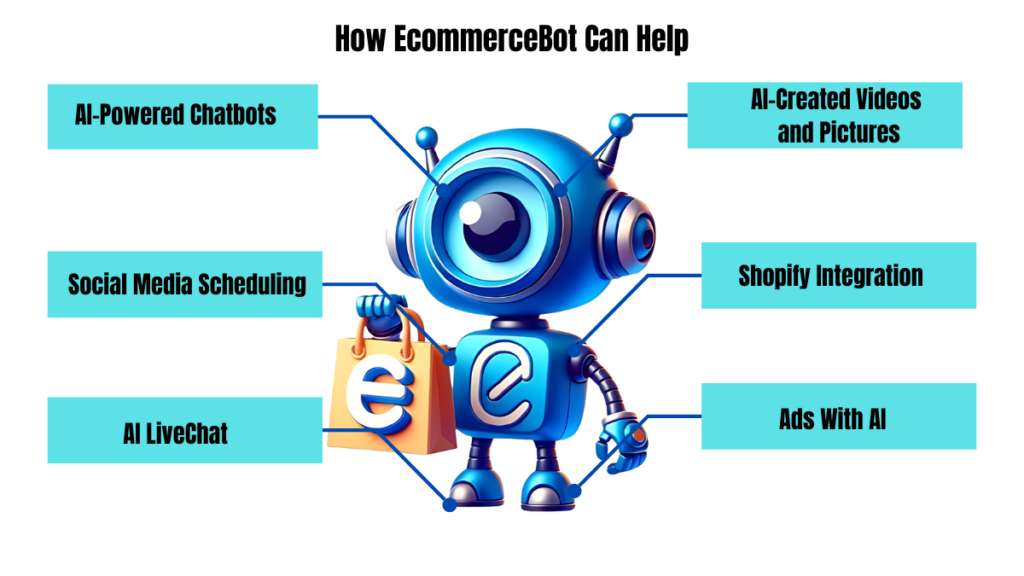
- AI-Created Videos and Pictures: Generate product videos and picture variations based on prompts.
- Shopify Integration: Track profit and sales metrics, manage orders, analyze product performance, and monitor inventory.
- Ads With AI: Run, Test, & Scale profitable ads with AI. Save time and budget on ads that will never become profitable.
Section 2: Customer Service Automation
Importance of Great Customer Service
Providing exceptional customer service is critical for ecommerce success. Research indicates that 91% of customers will likely make another purchase after an excellent customer service experience.
Furthermore, 80% of consumers have changed their mind about a purchase due to a poor customer service experience. Therefore, ensuring consistent, high-quality customer service is essential for retaining customers and driving repeat business.
How to Automate Customer Service
Automation is vital to maintaining high customer service standards while scaling your business. Automating customer service allows you to handle many inquiries efficiently, ensuring timely and accurate responses.
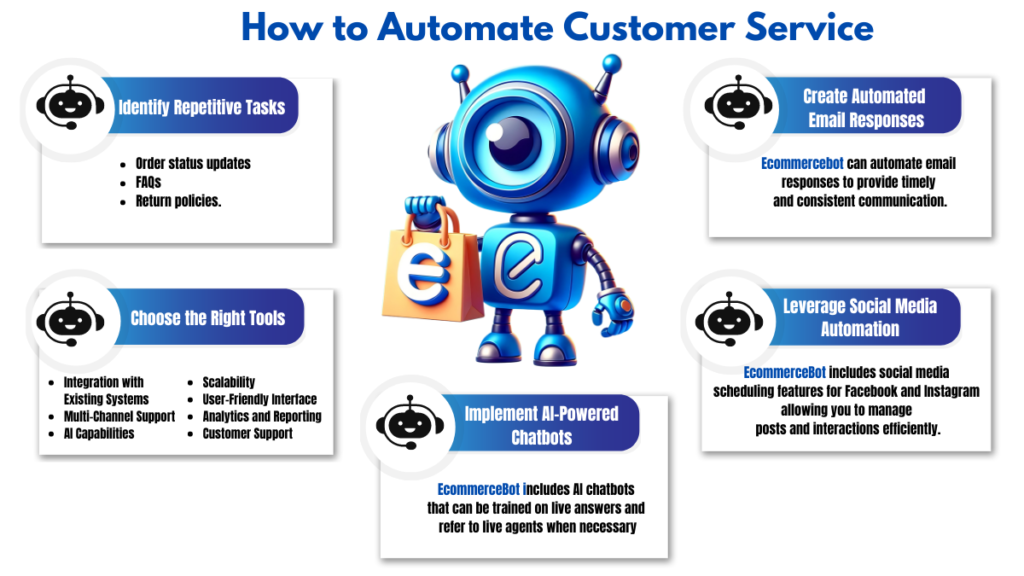
Here’s how to get started:
- Identify Repetitive Tasks:
- List common customer inquiries and issues that can be addressed through automation. Examples include order status updates, FAQs, and return policies.
- Choose the Right Tools:
- Integration with Existing Systems: Ensure the tool integrates seamlessly with your existing Shopify store and other systems. EcommerceBot offers seamless integration with Shopify, allowing you to manage customer service directly from your Inbox.
- Multi-Channel Support: Select tools that handle multiple communication channels, such as live chat, email, and social media. EcommerceBot supports customer interactions across Instagram DM, Facebook DM, and email.
- AI Capabilities: Opt for tools with advanced AI capabilities to handle more complex inquiries and provide personalized responses. EcommerceBot features AI-powered chatbots that can answer common questions and learn from each interaction to improve over time.
- Scalability: Choose a solution that can grow with your business, accommodating increasing inquiries without degrading performance. EcommerceBot is designed to scale with your business needs.
- User-Friendly Interface: The tool should be easy for you and your customers to set up and use. EcommerceBot offers a user-friendly interface that simplifies setup and usage.
- Analytics and Reporting: Ensure the tool offers comprehensive analytics to track performance and identify areas for improvement. EcommerceBot provides detailed analytics and reporting to help you monitor customer service performance.
- Customer Support: Reliable customer support from the tool provider is essential to address any issues quickly and efficiently.
- Implement AI-Powered Chatbots:
- Use AI chatbots to respond instantly to common questions and guide customers through simple processes. Chatbots can handle inquiries 24/7, ensuring your customers receive support at any time. EcommerceBot includes AI chatbots that can be trained on live answers and refer to live agents when necessary. Suppose the bot encounters a question it has yet to be trained on. In that case, it either transfers the query to a live agent (if available) or collects the customer’s information for follow-up, ensuring continuous improvement by learning from each interaction.
- Create Automated Email Responses:
- Set up automated email sequences to acknowledge receipt of inquiries and provide expected response times. Use email automation to follow up with customers after purchases, ask for reviews, and offer support. EcommerceBot can automate email responses to provide timely and consistent communication.
- Leverage Social Media Automation:
- Automate responses to direct messages and comments on social media platforms. Use automation tools to schedule posts and engage with your audience consistently. EcommerceBot includes social media scheduling features for Facebook and Instagram, allowing you to manage posts and interactions efficiently.
Benefits of Automation
Automating customer service offers several benefits, including:
- Time Savings: Free up time for you and your team to focus on strategic tasks and growth initiatives (Oberlo | Where Self Made is Made).
- Improved Efficiency: Handle a high volume of inquiries without compromising response times or accuracy (Nextiva).
- Enhanced Customer Satisfaction: Provide quick and consistent responses, increasing customer satisfaction and loyalty (AI Customer Care).
- Scalability: Easily scale your customer service operations without proportionally increasing your team size.
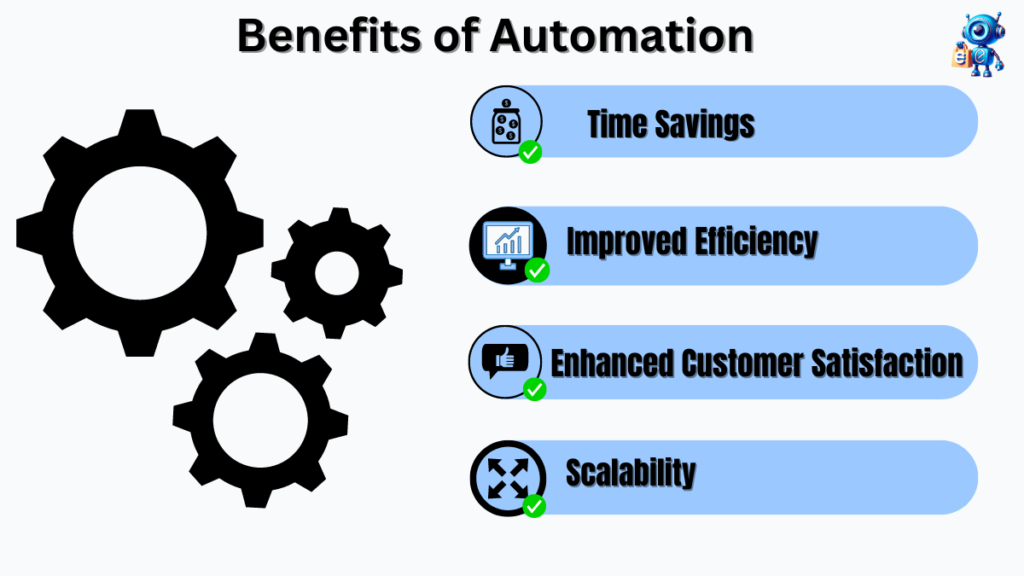
Creating the Need for Automation
After creating your Shopify store, it will start to grow, and with time, so will the volume of customer inquiries and the complexity of managing them. Manual customer service handling becomes unsustainable, leading to longer response times, potential errors, and decreased customer satisfaction. Automating these processes is essential to maintaining high service standards while freeing up resources to focus on scaling your business.
How EcommerceBot Can Help
- AI-Powered Chatbots: Automate customer service inquiries across multiple channels, including Instagram DM and Facebook DM.
- Social Media Scheduling: Schedule posts on Facebook and Instagram with a calendar feature.
- AI LiveChat: Engage customers with product images, buy-now buttons, add-to-cart options, and email collection directly in chat.
- Automated Email Responses: Set up automated email sequences to follow up with customers after purchases and provide timely support.
- Centralized Customer Service Management: Manage all customer service interactions from a single platform, ensuring consistency and efficiency.
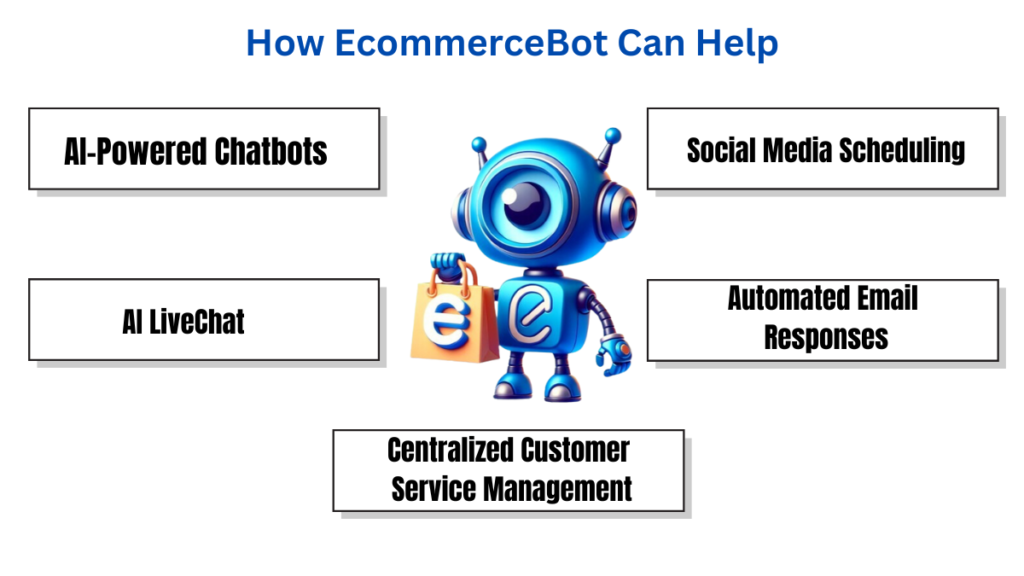
With this approach, we ensure that the content is educational and emphasizes the necessity and benefits of customer service automation, creating a compelling case for using EcommerceBot.
Section 3: Organic Traffic Growth
Organic traffic growth is essential for the success of any ecommerce business. According to statistics, 53.3% of website traffic comes directly from organic search, while only 27% comes from paid search. Thus, it is clear that organic traffic is essential for the growth of website visitors.
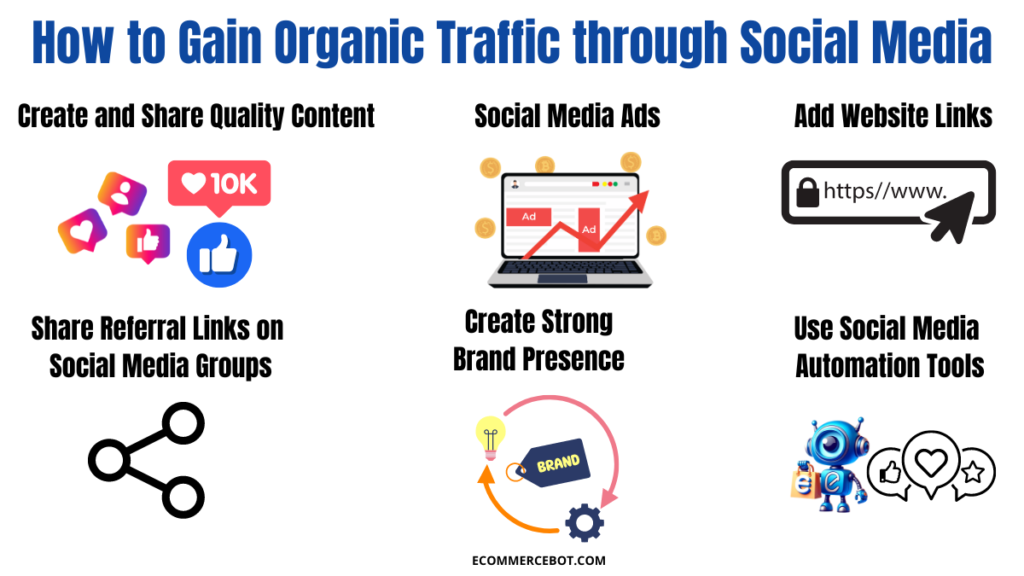
Implement SEO, social media marketing, and influencer marketing to generate and grow organic traffic for your website.
Strategies for Increasing Organic Traffic Growth
There are some proven strategies that you can implement into your business website to grow your organic traffic. These strategies will help you boost your traffic, thus increasing leads, conversions, and sales.
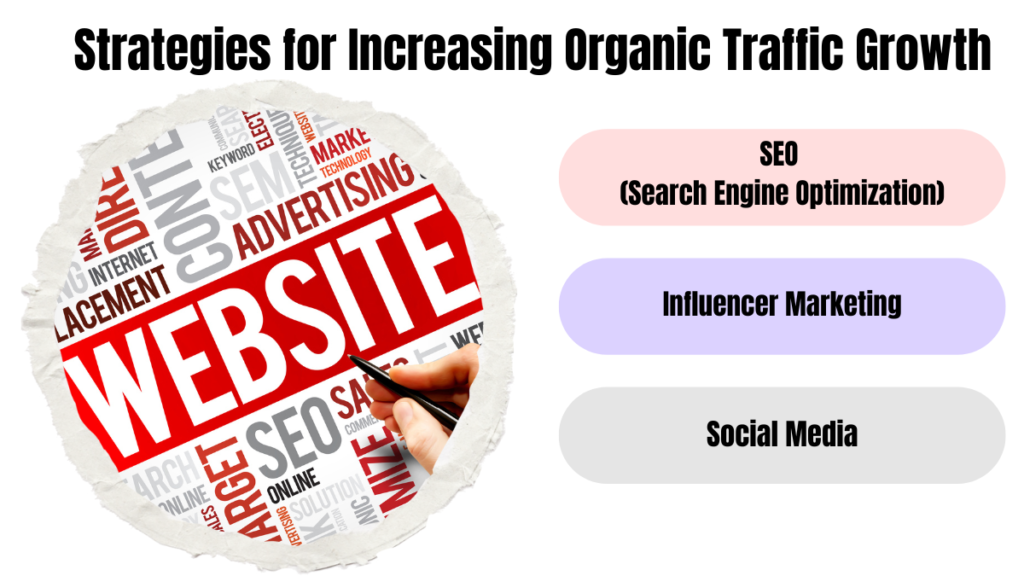
Here are some strategies that you can use;
SEO (Search Engine Optimization)
Search engine optimization (SEO) involves improving your website to increase its visibility on search engines like Google, Bing, and others when people search for services, products, or information.
For people to find and click on your pages, products, or services, you must ensure your website is visible on the search engines. SEO’s primary goal is to assist you in attracting visitors to your website who turn into loyal customers, audiences, or clients.
Why is SEO Important?
When it comes to marketing, SEO is a critical aspect that you need to use for your business.
But why is SEO important for your business?
- Web Traffic—Organic search is one of the most common sources of traffic for businesses. Studies have shown that most website traffic comes from SEO, compared to PPC (pay-per-click).
- Visibility and Rankings—SEO helps boost your brand visibility, making it easy for potential customers to find you when searching for products or services you offer. With increased visibility, your brand will also rank on search engines.
- Boost Sales—With increased traffic and visibility, you will likely draw more customers to your website, who might turn into customers, thus improving your overall business sales.
- Cost-Effective-Using SEO for your website and marketing is one easy and affordable way to increase your traffic. Thus, it helps save money and time, unlike paid advertisements.
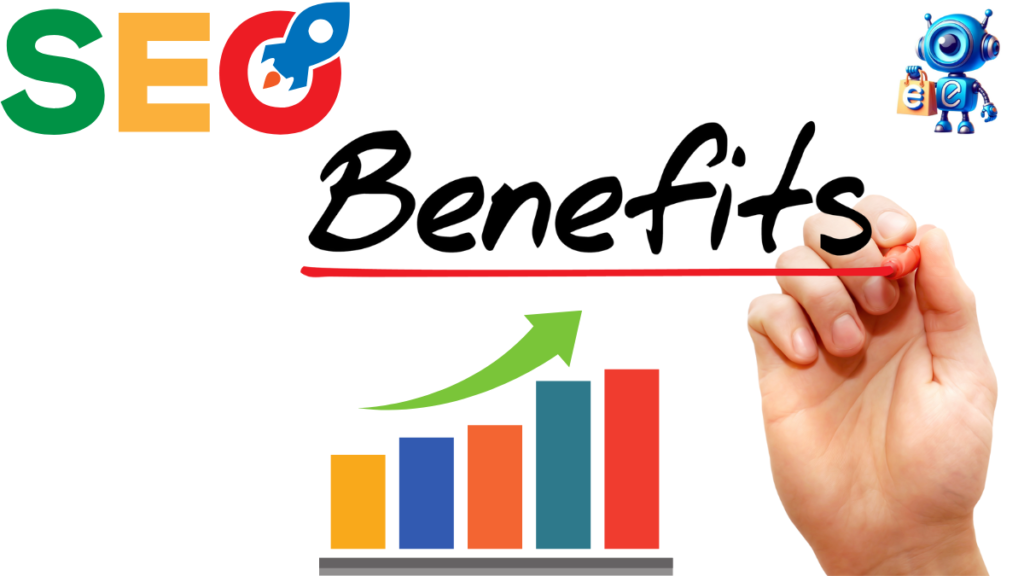
SEO Tips for Increasing Organic Traffic on Your Business
Using SEO to grow organic traffic for your business gives you a competitive edge. Most business owners focus on paid traffic, which generates less traffic than SEO traffic.
1. Keyword Research: The first step is to identify keywords your target audience is searching for and choose the one you want your business to rank for. You can use keyword research tools like Google Trends, Semrush, and Ahrefs.
Use the keywords in product titles, descriptions, hashtags, and more. It will help you target the right keyword, thus improving your overall store visibility.
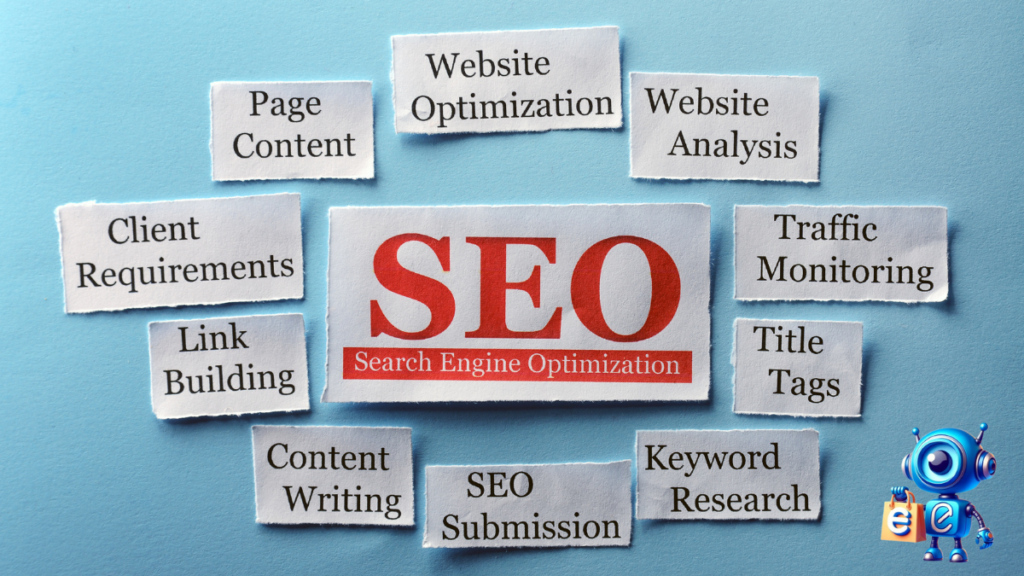
2. Optimize your Product Titles, Meta, and URL: When writing titles for your products, ensure they are clear and have the right keyword you are using. Include the keyword in your meta descriptions and URL. Ensure they are short and engaging to encourage more people to visit your store.
3. Avoid Duplicate Content: Duplicate content mainly occurs when you copy information directly from another website. Google penalizes such websites, so avoiding such content on your business website is essential. If your site has any, ensure you fix it in advance.
4. Fast Loading Speed: Your e-commerce site’s speed is vital, as most customers prefer a site that loads fast. According to Google reports, most customers will likely leave your website if it takes over 3 seconds to load.
Here are a few tips that can help you increase your site speed;
- Optimize images
- Compress your images and files.
- Remove unnecessary plugins and apps.
- Audit your website
- Track 404 errors
- Choose a good hosting provider.
- Reduce the total redirects.
- Limit the number of HTTP requests.
To improve your site speed, work on the above factors affecting your website’s speed and optimize these factors to improve the site speed.
5. High-Quality Backlinks: Backlinks are other websites that link to your website. In short, they vouch for your website. If other sites link to your business store, it shows that your website offers quality content and deserves to rank high on search engines.
Analyze this backlink well with tools like Ahrefs, BuzzSumo, and Moz Link Explorer. To get quality backlinks for your store, you can use the following tips;
- Contact bloggers or influencers for features or reviews
- Create and share quality content that people might want to link
- Share your industry expertise in different communities and forums
6. Optimize Product Descriptions and Pages: Optimizing your product descriptions and pages will increase your brand visibility on search engines, thus increasing your overall organic traffic and making it easier for customers to find your products.
Ensure that you include the following in your product descriptions and pages;
- Relevant keywords
- Optimized and high-quality images
- Write short, clear, and engaging descriptions that focus on the benefit
7. Start a Blog: A good blog that focuses on educating your customers about your products, their benefits, and why they should buy them can help you increase organic traffic to your store. Ensure all your content is high quality and has relevant keywords, especially long-tail ones.
You should periodically run an SEO audit for your e-commerce store to identify areas that need optimization for better results.
Influencer Marketing
It is a type of social media marketing involving influencers to mention or endorse your products on their social media channels. These people have many followers and are experts within a specific niche.
Most people trust influencers, so when you invest in influencer marketing, people will likely visit your website, increasing organic traffic. Working with some influencers is cheap, as 93% of influencers are ready to work with you in exchange for complimentary products.
How to Work with Influencers
Working with influencers is relatively easy, and they can help you increase your organic traffic. Here is a step-by-step guide on how you can get started working with influencers;
1. Choose the Right Influencer: Many influencers are available, but getting the right influencer for your products can be challenging.
Here are some tips that can help you choose the right influencer for your business;
- Choose an influencer whose interests, followers, and values align with the brand.
- Check their social media followers
- Ensure the followers are real and not bots
- Analyze the engagement rate of the influencer
- Please make sure they post consistently and quality posts
2. Understand Different Levels of Influencer: There are different types of influencers to select from. These Influencer category prices range with the number of followers. The primary influencer types include;
- Nano Influencers– This type of influencer has below 10,000 followers.
- Micro-Influencers– Micro-influencers have between 10,000 and 50,000 followers
- Macro Influencers– It is the second largest influencer category with 100,000 up to 1 million followers.
- Mega Influencer- Just from the term mega, this is the most significant type of influencer with more than 1 million followers.
Depending on your business needs, goals, and budget, it will be easy to determine which category of influencers suits your business.
3. Reach Out: To reach out to your ideal influencer, you can start by following them and interacting with their accounts by commenting on and liking their posts. You can message them directly when you are ready to get their quotes. Give them enough details about your brand.
4. Strike a Deal: After contacting your ideal influencer and receiving their pricing quote, it’s time to strike a deal. Since influencers value their reputation, you need to agree on their terms to avoid ruining their online reputation. Then, you can sign a partnership with them.
Social Media
Recently, the number of social media users has been increasing daily. Today, more than half of the world’s population uses social media daily. 62.6% of people use social media. The numbers don’t lie, and it is evident that leveraging social media to gain organic traffic is lucrative.

How to Gain Organic Traffic through Social Media
Leveraging the platforms with the right social media strategy can help businesses boost traffic and increase sales.
But how can you use social media to grow organic traffic?

- Create and Share Quality Content: Quality content is king. You must create quality content and share it on your social media channels like Facebook, Instagram, TikTok, and more. Write engaging, well-written content that targets your audience and addresses their problems and interests. Also, maintain consistency to establish yourself as an industry leader. Include a link on the posts that leads people to your business website.
- Social Media Ads: With the rise of AI, creating ads for social media channels like Facebook or Instagram is now accessible. You can create different ads like sponsored posts, video ads, and carousel ads. To make it easy, you can use Ecommercebot to develop and optimize your ads. Optimize your ad description with relevant keywords and add a link to your site.
- Add Website Links: You can add a referral link to your website on your social media profile. Usually, this link is added to your bio area. Thus, users can click the link for more information about your business.
- Share Referral Links on Social Media Groups: Social media channels have many groups that you can leverage to increase organic traffic to your website. Find groups under your business category, then share referral links to those groups.
- Create Strong Brand Presence: To drive organic traffic to your website, establish a solid, trustworthy brand presence on social media. A good brand should have an appealing look and constantly interact with customers. You can use tools like Ecommercebot to automate commenting on posts and interacting with customers on DMs.
- Use Social Media Automation Tools: Social media automation tools can help you optimize and streamline your marketing efforts and increase organic traffic on your website. These tools allow you to comment on your posts, automate social media posts, track analytics, and respond to DMs. One tool that can help you automate social media is Ecommercebot.
Section 4: Effective Paid Strategies
The digital world is evolving rapidly, and the introduction of Artificial Intelligence (AI) plays a crucial role in different sectors, especially marketing.
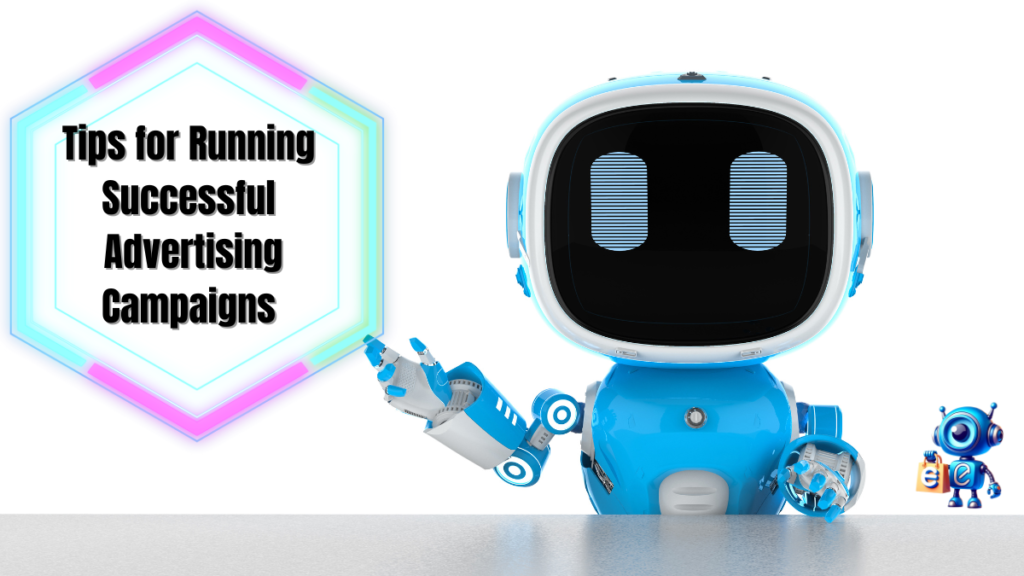
Creating and running marketing campaigns is easy today as AI tools automate the process. A business leveraging AI’s power helps improve its marketing campaigns and drive better results in its ecommerce business.
Tips for Running Successful Advertising Campaigns
To run successful marketing campaigns that maximize your business ROI using minimal resources, you must be strategic and create ads targeting your correct target audience. Here are some tips that you can use;
- Choose the Right AI Tools: The market is saturated with many AI tools with enticing features. Thus, choosing the wrong tool is easy and can negatively impact your business. Choose a tool that meets your marketing goals. Ensure the tool is easy to use and seamlessly integrates with existing systems.
- Keep the Message Simple: Most people need help remembering small details, so your marketing message needs to be short and straightforward. Incorporate the KISS marketing strategy: “Keep it Simple, Stupid.” Make the headline catchy, and all other details in the ad should support it.
- Ensure your Ad is Competitive: Thoroughly research your competitors and analyze how they have created their ads. Now, make your ad more unique and catchy than your competitor’s. Test your ad or use personal judgment, then compare it with your competitor’s ad to see if yours is memorable, unique, credible, and catchy to purchase.
- Go Where Your Target Audience Is: Before creating or posting your ad campaigns, research where you can find a large number of your target audience. This will help you reach the right audience for your business. Choose a digital or traditional platform and ensure it has a considerable following.
- Optimize your Ad Campaigns: One way to get good results from your ad campaigns is to optimize the ad with SEO to reach higher engagements. When optimizing, you can try A/B testing, personalized targeting, content optimization, or dynamic pricing.
Benefits of AI Ads Automation
Running Ads with AI has many benefits for your business, such as;
- Target the right audience: AI ad automation helps you create ads targeting the right audience.
- Easy Ad Creation: Automating the ad creation process for your business makes the process easy, as the tools generate different ads in seconds.
- Improves customer experience: AI helps business owners better understand their customers’ behavior, thus creating ads tailored to solve their problems. Furthermore, offering personalized services improves customer communication.
- Reach a wider audience: By using AI for ad campaigns, you can reach a broad audience by trying different campaigns to see what works and what you need to improve.
- Understanding customers’ journey: AI ads automation allows you to track your customers’ journey and work on improving future ad campaigns.
How Ecommercebot Can Help
- Seamless Ad Creation: Ecommercebot makes the ad creation process seamless. You upload your content, and then Ecommercebot automatically creates and optimizes ads.
- Intelligent Optimization: Not all ads will perform better; Ecommercebot pauses all non-performers automatically and boosts the ones performing better.
- Precise Targeting: Reach the right target audience and increase higher engagements.
- Multiple-Platform Support: Offer support on platforms like Facebook, Instagram, and Target.
Section 5:Improve Customer LTV
Customer LTV (Lifetime Value) is the estimated revenue that a customer generates for your brand throughout their lifetime as a customer. The LTV helps you understand how your customers resonate with your products and the areas you need to improve.
To improve customer LTV, you need to work on ways to retain them and increase repeat purchases.
Importance of Customer LTV
Customer LTV is essential for your business as it helps you save money and makes it easier to retain old clients than to acquire new ones. Therefore, for your business to succeed, you need to work on increasing the lifetime of your existing customers, which can help boost business growth.
Another critical aspect of customer LTV is to spot any signs of attrition in advance and work on combating them. You can introduce loyalty programs to tempt and draw the customer back or offer exceptional customer support. By doing this, you will boost the customer’s LTV.
Lastly, customer LTV helps you identify the best customers and ensure they have a higher lifetime value. It will also help you understand what occasionally motivates them to purchase from you. From these insights, you can define the customer segment.
Techniques to Increase Customer Retention and Repeat Purchases
Retaining customers is much easier than acquiring new ones. Thus, trying to maintain your current customers before you consider acquiring new ones is essential.
- Communicate with your Customers: Communication is the key to the success of any business. You need to provide customers with 24/7 support. To make it easy, you can integrate your business with a chatbot like Ecommercebot to offer instant customer support to your customer.
- Offer Easy Refund Policy: One way to ensure customers keep purchasing is to provide an easy refund policy. Mistakes can happen, and your customer may request a refund; if you don’t give them, then say goodbye to the customer as they can never purchase from you again.
- Build Trust with Your Customer: When building trust with customers, don’t assume they are buying from you because they trust you. Building trust can take time. Ensure that you fulfill all the promises you make to them.
- Offer Unique Services: It can be challenging to offer your customers unique products and services that your competitors offer, but the results are promising. Look for a niche in which you can help customers solve their problems with your brand.
- Offer Fast Delivery: Delivery is a significant concern, and most customers value fast delivery. Therefore, to retain customers, you must offer quick delivery and update them on delivery status.
- Be Understanding. Offering the best and highest-quality product can make you assume you have market dominance, but that’s just a lie. Give your customers easy-to-understand marketing materials. Make your business accessible to your customers to build trust.
Section 6: Cart Abandonment Solutions
The rate of cart abandonment has been increasing in the past few years. However, in 2023, the cart abandonment rate increased to 70%, a 10% increase from the past years. With this, most businesses are affected by cart abandonment as most of their customers fail to finalize their purchases. The total amount from cart abandonment equals $4 trillion per year.
Why People Abandon Their Carts
The current rate of cart abandonment is highly alarming for businesses. Nothing is more painful than a client leaving without finalizing their purchase. Therefore, as a business owner, you must understand the significant causes of cart abandonment.
- High Shipping Cost: Many customers abandon their carts before finalizing their purchases because the shipping cost is too high.
- Lack of Express Shipping: Customers value fast shipping more than the cost of shipping. Therefore, if your business can’t afford to deliver goods in time, customers are likely to abandon their carts.
- Lack of Trust: Providing financial information, especially credit or card details, can raise a risk level, especially if customers don’t find your business trustworthy.
- Technical Issues: Technical issues significantly contribute to the increase in cart abandonment. Issues like slow site speed, error pages, and frequent error messages affect the overall customer experience.
- Limited Payment Options: Offering limited payment options can increase cart abandonment rates. Customers need to be able to choose their preferred method; when they can’t find it, they will likely abandon the cart.
How to Reduce Cart Abandonment Rate
For your ecommerce business to succeed, you need to work on reducing the cart abandonment rate and growing your revenue. Most cart abandonment causes have solutions you can work on to reduce the rate and enhance the customer experience.
1. Easy Checkout: 17% of customers abandon their carts due to a complicated checkout process. Your checkout needs to be easy and fast, and your customers should be able to check out within a maximum of four minutes. You can reduce the required steps and offer autofill options to achieve this.
2. Use Live Chat: Adding a live chat to your Shopify store is another excellent technique for reducing cart abandonment rates. With a live chat, you can help your customers with questions about their products, orders, or checkout throughout their shopping journey.
3. Multiple Payments: Customers are more convenient with businesses offering numerous payment options. To meet each customer’s preference, try offering various payment methods, including debit and credit cards and digital wallets. Allowing customers to choose their preferred payment method increases the chances of most customers completing their purchase.
4. Be Transparent: Hidden fees at the checkout are one major drawback leading to increased cart abandonment rates. Tell your customers about added shopping fees, including taxes and shipping costs. Being transparent to your customers helps reduce the cart abandonment rate.
5. Offer Free Shipping: Many customers are always ready to say yes to free shipping. Free shipping helps reduce your customers’ purchase costs, making it easy for them to complete their purchases.
6. Include a Strong CTA: Users will likely abandon their carts when you don’t give them a clear way forward. Use CTA to show them the next step in the shopping journey. Ensure the CTAs are straightforward, like “Buy Now” or “Add to Cart.” Allow them to review their purchases before finalizing their purchase.
7. Follow-Up Emails: You must send personalized emails to your customers reminding them what is in their carts. Persuade them to complete their purchase and give more product recommendations for what’s on their carts.
8. Customer Survey: Before finding solutions for your cart abandonment rate, you must understand why your customers are abandoning them. The best way to do this is to survey your customers and understand the main reason behind their cart abandonment. You can also track a customer’s journey on your site to identify issues like slow site speed, complex navigation, or broken links that might affect your customer’s journey.
9. Offer Guest Checkout: Creating accounts or logging in anytime before purchasing is another major cause of cart abandonment. Sometimes, a customer might need to remember the login details and thus abandon your store and purchase elsewhere. You can reduce this by offering your customers guest checkout, which they can complete quickly.
Section 7: Optimize Conversion Rates
E-commerce business owners, especially those on Shopify, mainly focus on driving website traffic.
Having good traffic in your store is good, but what’s the use of it if you don’t convert these visitors?
Conversion rate optimization uses different strategies to increase the number of visitors who convert or take action on your store.
For Shopify store owners, conversion means turning your store visitors into customers.
How to Calculate Conversion Rates
Before optimizing your conversion rate, you must understand how to calculate it. The process is simple: Divide the number of conversions by the total number of website visits, then multiply the number by 100 to get the total percentage. All this needs to be done within a certain period.
Conversion rate (%) = Number of Conversion/ Number of Visitors x100
After getting the conversion rate, you will know if your store conversion rate is reasonable or needs improvement.
A reasonable conversion rate should be between 2% and 5%. However, this will depend on factors such as the target audience, industry, and business type.
If your store’s conversion rate is below 1%, that is a meager rate for a business, and you need to improve it.
Benefit of Conversion Rate Optimization
CRO has many benefits for ecommerce store owners, including sales, leads, and marketing processes.
Let’s see the significant benefit of conversion rate optimization;
- Low Cost Per Acquisition (CPA): Your business website’s CRO can help decrease the CPA. This results in your business not needing to invest in multiple channels or strategies that can help you increase your conversion rate.
- Data-Based Decisions: Without the CRO, business decisions are always based on guesswork. With the CRO, you make business decisions based on data and facts you have collected. You can use the A/B tests or evaluate the results to make intelligent business decisions.
- Increased Revenue and Sales: Conversion rate optimization helps businesses convert site visitors to customers, thus increasing their overall sales and revenue.
- Better Understanding of Customers: CRO involves thoroughly researching your business and customers. During the process, you will understand why they purchase from your business and what you can improve to encourage them to take action.
- Get a Competitive Edge: If you optimize your conversion rate and your competitors don’t, you are likely to outrank them when your conversion rate increases; your social presence, traffic, and popularity will also increase.
Strategies for Improving Shopify Conversion Rate
After gaining visitors to your website, you need to turn them into customers. Some people may come to your store just to window shop, but if you give them a reason to purchase, they are likely to convert, thus increasing your conversion rates, revenue, leads, and sales.
1. Create Unique Product Pages: The customer shopping journey begins on the product pages, and the buying decision is mainly made here. Thus, to convert visitors to customers, you need unique product pages that convince them to buy with detailed information about the product’s benefits.
2. Add Social Proof: Buyers trust businesses with previous customer reviews online. Most people read reviews and feedback on your products before deciding. To improve your Shopify conversion rate, you must add reviews and feedback from past customers to your store.
3. Optimize Checkout Page: Your checkout needs to be simple to streamline the process, making it seamless. Many customers abandon carts due to the complicated checkout process, thus reducing the conversion rate. Optimize your checkout by including autofill features, simplifying the form fields, and giving multiple payment methods.
4. Optimize Site Speed and Mobile Responsiveness: Today, a high traffic rate is coming from mobile devices; thus, making your site mobile responsive is no longer a luxury but a must. Furthermore, your site must load fast, as customers leave websites with slow loading speeds.
5. Add a Live Chat: Customers value fast responses when they need assistance while shopping. If you take long to respond, most will likely leave your store and purchase from your competitors. To avoid this, include a live chat like Ecommercebot to offer customers instant responses.
6. Utilize Loyalty Program: You need visitors to your store to convert them to customers. Give these visitors rewards, exclusive offers, free shipping, and discounts. It will help transform them quickly into customers. Use the Shopify loyalty app to reward your visitors with what you want.
7. Upsell and cross-sell: Upselling and cross-sell a perfect strategy for increasing your conversion rate. But remember to limit the number of choices that you want to offer. Giving unlimited choices can distract the customer’s shopping journey before completing the journey.
Section 8: Scaling your Business
Venturing into the e-commerce business model is an exciting adventure with endless possibilities. With internet users increasing each day globally, the number of people embracing online shopping is growing. In 2024, total e-commerce sales are estimated to surpass $6.3 trillion.

Scaling your business involves increasing its revenue while maintaining its cost. For ecommerce businesses, scalability evolves on maximizing both profitability and efficiency by leveraging the available technologies and resources.
How to Scale Your Ecommerce Business
Scaling your business is a significant decision and step. You will make this decision in one way or another, but take your time to take this big step when your business is still in the early stages.
Before scaling, ensure you have a proper foundation to avoid making mistakes. So, let’s go through some of the significant steps to take when scaling your ecommerce business.
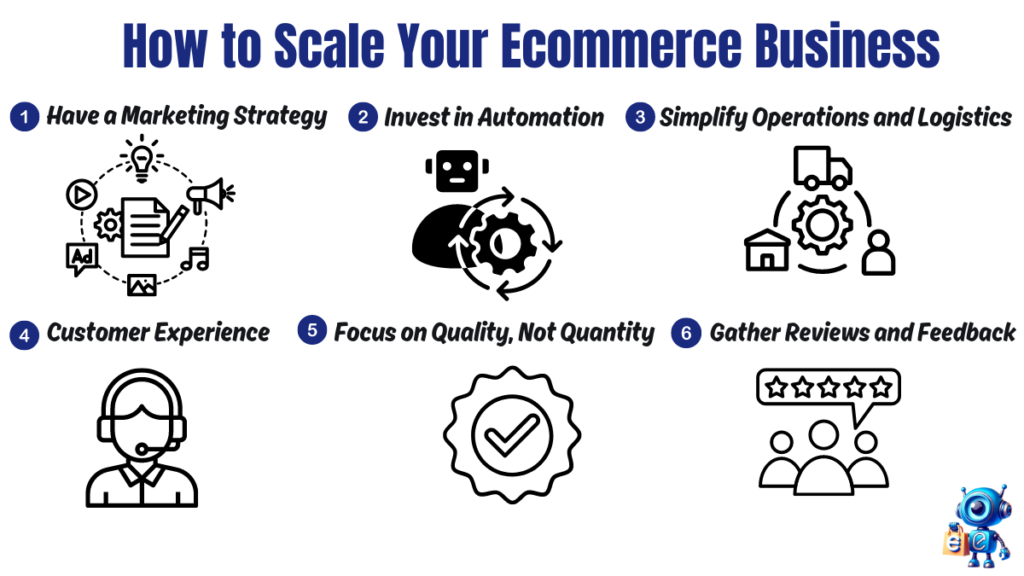
Step 1: Have a Marketing Strategy
For the world to know your business exists, you need a winning strategy to give you results. There is no specific strategy that you can use, but there are areas that you can focus on in your marketing strategy, such as SEO, paid marketing, and retargeting.
Step 2: Invest in Automation
If you are ready, you must invest in automation tools to help you complete most tasks. When you scale your business, customer and business demands will likely increase; thus, you need an automation tool to help you handle the increase without affecting the customer experience journey.
For example, using Ecommercebot will take over most tasks, such as tracking inventory, answering customers, scheduling social media posts, commenting on your posts, and more. It gives you and your team enough time to focus on complex tasks.
Step 3: Simplify Operations and Logistics
When most business owners start scaling their businesses, they forget about logistics, a killer mistake. Streamline your operations to handle the high demand without compromising product quality and shipping time. Implement shipping solutions, inventory management systems, and order processing workflows.
Step 4: Customer Experience
When investing in automation tools for customer support, ensure the tool will not interfere with the quality of your customer support experience. Focus on providing your customers with personalized support and make them happy. Invest in chatbots to handle customers’ queries and connect them to a live agent for complex questions or human-touch support.
Step 5: Focus on Quality, Not Quantity
After your business starts to scale, forgetting about the quality you offer is easy, and start focusing on providing quantity to increase your sales. But this is a mistake you are making that will start killing your business slowly. You need to maintain the quality of your products. During the scaling process, collect customer data, analyze the data, and improve your strategies for better results.
Step 6: Gather Reviews and Feedback
It is just like the success of every ecommerce success step; it relies on reviews. Before a customer purchases primarily online, the decision is mainly influenced by factors like past customer reviews. Thus, you need to gather them and display them in your store.
Other than influencing buyer decisions, customer reviews play a crucial part in;
- Boosting search engine rankings
- Increase the click-through rates (CTRs)
- Enhance customer experience
- Increase consumer trust
Handling the Rise in Demand with Ecommercebot
Ecommerce platforms like Shopify are designed to handle a specific capacity. The platform might need help to handle the rise when the set capacity increases. Also, as a business owner, it is challenging to fulfill all your customers’ needs and meet the new demands.
When your business starts to scale, customer demands for better and faster services increase. However, to scale without compromising quality and customer support, that’s where Ecommercebot comes in.
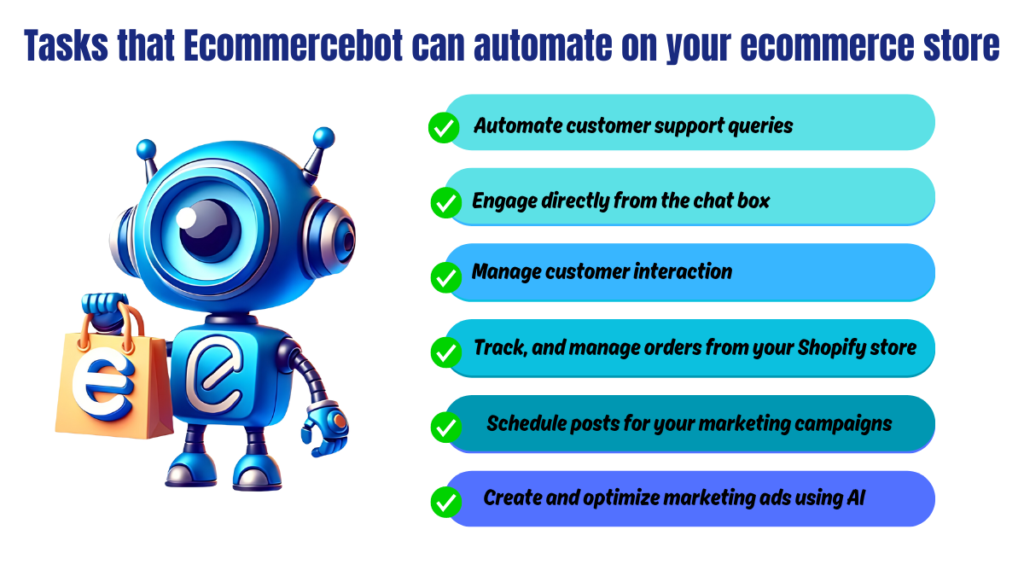
Ecommercebot is an AI-powered chatbot that can help you scale your e-commerce business without affecting the customer experience. It also allows you to handle complex tasks, leaving the simple ones to the bot.
Here are some of the tasks that Ecommercebot can automate on your ecommerce store;
- Automate customer support queries on social media channels like Facebook and Instagram DMs.
- Engage directly with your customers by sharing product images, adding to your cart, using buying now buttons, and collecting emails—all from the chat box.
- Manage customer interaction from a simple platform.
- Track profit, manage orders and sales metrics, monitor inventory, and analyze product performance from your Shopify store.
- Schedule posts on Instagram and Facebook for your marketing campaigns.
- Using AI, create and optimize marketing ads for Google, TikTok, and Meta.
Summary on Scaling Shopify Store
Since its launch, Shopify’s popularity has been booming, making it a perfect e-commerce platform.
The Shopify success rate ranges between 5% and 10%; thus, with the proper guidance, your store might succeed within the first months.
To succeed on this platform, you need to scale your Shopify store. We have covered every method for scaling your store from $X to $100K monthly revenue.
However, one method that stands out is investing in automation tools like Ecommercebot to automate most of your store, customer, and marketing activities.
Our bot has a 30-day free trial to take advantage of and watch it to help you scale your Shopify store.
Resources and References
Customer Service Statistics:
- 91% of customers will likely make another purchase after an excellent customer service experience (AI Customer Care).
- 80% of consumers have changed their mind about a purchase due to a poor customer service experience.
Choosing the Right Tools:
- Integration with existing systems and multi-channel support is critical for effective customer service automation (AI Customer Care).
Organic Traffic Growth:
- 53.3% of website traffic comes directly from organic search, while only 27% comes from paid search (BrightEdge).
- 93% of influencers are ready to work with you in exchange for complimentary products (Aspire).
Cart Abandonment:
- The cart abandonment rate increased to 70%, a 10% increase from the past years (Statista).
- 17% of customers abandon their carts due to a complicated checkout process (Baymard Institute)
Scaling your Business:
- In 2024, the total ecommerce sales are estimated to surpass $6.3 trillion (Statista)

